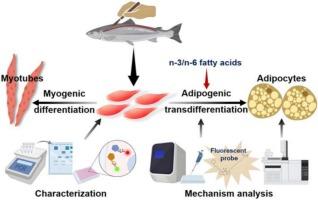Establishment of a continuous Atlantic salmon muscle cell line for cell-cultured fish meat and characterization of its adipogenic transdifferentiation induced by n-3 and n-6 fatty acids
IF 8
1区 农林科学
Q1 FOOD SCIENCE & TECHNOLOGY
引用次数: 0
Abstract
The precise regulation of fatty acid (FA) synthesis and lipid metabolism is crucial for adipogenesis in cell-cultured fish meat (CFM). In this study, a continuous muscle cell line from Atlantic salmon (SsMCs) was established and characterised, and the effects of n-3 and n-6 fatty acids (n-3/n-6 FAs) on adipogenic transdifferentiation were also elucidated. The SsMCs exhibited myogenic differentiation, adipogenic transdifferentiation capacity and transfection potential. n-3/n-6 FAs differentially affected adipogenic transdifferentiation in SsMCs, with linoleic acid (LA) showing the most pronounced effect. Furthermore, n-3/n-6 FAs promoted adipogenic transdifferentiation in SsMCs through the activation of the adipogenic transcriptional cascade. LA induced lower carnitine palmitoyltransferase I and higher FA synthase activity, and elevated cellular lipid peroxidation levels, which may collectively enhance LA-driven adipogenic transdifferentiation. FA profiling analysis revealed that SsMCs could effectively absorb and deposit n-3/n-6 FAs and possessed a certain capacity for synthesising polyunsaturated FAs. This study provides a suitable seed cell line for CFM and lays a foundation for regulating lipid composition in cell-cultured fish fat.

用于细胞培养鱼肉的大西洋鲑鱼连续肌细胞系的建立及其n-3和n-6脂肪酸诱导成脂转分化的研究
脂肪酸(FA)合成和脂质代谢的精确调控是细胞培养鱼肉(CFM)脂肪形成的关键。本研究建立了大西洋鲑鱼(SsMCs)的连续肌细胞系,并对其进行了表征,并阐明了n-3和n-6脂肪酸(n-3/n-6 FAs)在成脂转分化中的作用。SsMCs表现出成肌分化、成脂转分化能力和转染潜力。n-3/n-6脂肪酸对SsMCs的成脂转分化有不同的影响,其中亚油酸(LA)的影响最为显著。此外,n-3/n-6 FAs通过激活成脂转录级联促进SsMCs的成脂转分化。LA诱导肉毒碱棕榈酰基转移酶I降低,FA合成酶活性升高,细胞脂质过氧化水平升高,这些可能共同增强LA驱动的脂肪转化。FA谱分析表明,SsMCs能够有效吸收和沉积n-3/n-6脂肪酸,并具有一定的合成多不饱和脂肪酸的能力。本研究为CFM提供了合适的种子细胞系,为调节细胞培养鱼脂肪中的脂质组成奠定了基础。
本文章由计算机程序翻译,如有差异,请以英文原文为准。
求助全文
约1分钟内获得全文
求助全文
来源期刊

Food Research International
工程技术-食品科技
CiteScore
12.50
自引率
7.40%
发文量
1183
审稿时长
79 days
期刊介绍:
Food Research International serves as a rapid dissemination platform for significant and impactful research in food science, technology, engineering, and nutrition. The journal focuses on publishing novel, high-quality, and high-impact review papers, original research papers, and letters to the editors across various disciplines in the science and technology of food. Additionally, it follows a policy of publishing special issues on topical and emergent subjects in food research or related areas. Selected, peer-reviewed papers from scientific meetings, workshops, and conferences on the science, technology, and engineering of foods are also featured in special issues.
 求助内容:
求助内容: 应助结果提醒方式:
应助结果提醒方式:


